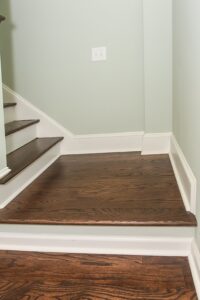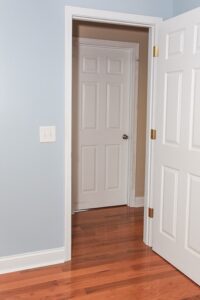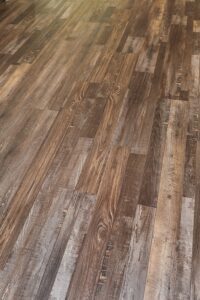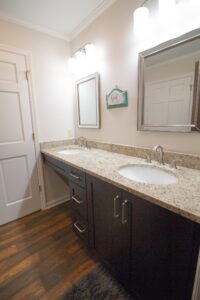What type of wood flooring is right for you?
Wood or wood-look flooring options have been popular for a while now, and their look and quality have only been getting better. There are options out there for every budget, but let’s look at some pros and cons of each type.
Types of wood flooring


First, let’s talk about the obvious classic: solid, natural hardwood. This type of flooring is 3/4-inch thick and varies in width options from typically 2.25 inches to 5 inches, along with some other custom sizes. This type of wood flooring comes either pre-finished, meaning it is finished in a limited number of colors in a factory and is shipped ready to install.
Solid hardwood also comes in unfinished that can be sanded and stained after install in a vast array of stain options and custom colors. Because of its thickness, solid hardwood can be refinished many times over the course of its life. A lot of homeowners like this option because of that fact.
On the flip side, solid hardwood needs just the right environment to stay stable. In warmer, humid areas, solid hardwood can be prone to warping or cupping, where the edges of the planks start to curl up to give you ridges in your floors. For that same reason, solid hardwood is not advised for use in basements or other potentially humid or wet areas.
Solid hardwoods are also susceptible to scratching, so be sure to consider the maintenance if you have pets or small children. The sand and finish process can also be a headache, causing lots of dust and putting you out of your home for a week or so.
Another option of natural hardwood flooring is engineered flooring. This type of flooring is composed of a thin layer of solid hardwood over a strengthened composite plywood for stability. Engineered wood flooring is much less susceptible to warping or shrinking than solid wood. This also allows it to be made in wider plank options, some options come in up to eight- or nine-inch widths.
This type of flooring uses less wood and glue than solid so is typically more environmentally friendly. It also is cheaper in both material and labor costs. The cons of engineered flooring, however, are that because of its thin top or wear-layer, it either cannot be refinished or may only be refinished once or twice. It is also prone to scratching, so if you have pets or small children and are considering this option, look for oil-finished options that will hide scratches the best.

A third option to get a wood-look flooring is luxury vinyl plank (LVP). As its name states, this is a vinyl product that comes in individual “planks” to give a more natural wood look. Rigid core options are often recommended for home installations because the pieces are not flimsy and have a pad built into each plank.
The look of luxury vinyl plank has increased significantly since it was first introduced with options that look just like wood and even have a wood grain texture you can feel. The colors are endless, too, with options from rustic to contemporary.
LVP is waterproof so can be used in any room in your home. It also holds up great to wear and tear from pets or heavy foot traffic. The price point is very reasonable, too. The negatives associated with LVP products are the connotation some still associate with the word “vinyl.” Also, if you think you may want to change the color of your floors in a few years, refinishing will not be an option, the floors will have to be replaced.
Wood-look tile is another option that has come a long way since it was first introduced. The look and feel of the tile “planks” is akin to natural wood, and is a great option, especially in wet areas of the home, such as basements, bathrooms, or laundry rooms.
The drawback of wood-look tile is often the price. The material price per square foot may be similar to the options above, however, the labor cost associated with tile is much, much higher. Plus, if you’re not a fan of cleaning grout, then tile may not be the best option for you.

There are of course other options out there, like laminate and sheet vinyl, that offer a wood look, but their popularity has been on the decline in recent years. Wood or wood-look flooring is probably one of the top requests I get as a home designer and remodeler. And with all the options available today, you can have that look, no matter your budget.
This article originally appeared in Lakeside News, in February 2022.
